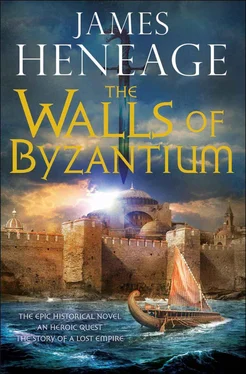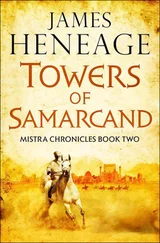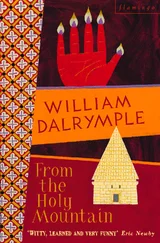James Heneage - The Walls of Byzantium
Здесь есть возможность читать онлайн «James Heneage - The Walls of Byzantium» весь текст электронной книги совершенно бесплатно (целиком полную версию без сокращений). В некоторых случаях можно слушать аудио, скачать через торрент в формате fb2 и присутствует краткое содержание. Жанр: Исторические приключения, на английском языке. Описание произведения, (предисловие) а так же отзывы посетителей доступны на портале библиотеки ЛибКат.
- Название:The Walls of Byzantium
- Автор:
- Жанр:
- Год:неизвестен
- ISBN:нет данных
- Рейтинг книги:3 / 5. Голосов: 1
-
Избранное:Добавить в избранное
- Отзывы:
-
Ваша оценка:
- 60
- 1
- 2
- 3
- 4
- 5
The Walls of Byzantium: краткое содержание, описание и аннотация
Предлагаем к чтению аннотацию, описание, краткое содержание или предисловие (зависит от того, что написал сам автор книги «The Walls of Byzantium»). Если вы не нашли необходимую информацию о книге — напишите в комментариях, мы постараемся отыскать её.
The Walls of Byzantium — читать онлайн бесплатно полную книгу (весь текст) целиком
Ниже представлен текст книги, разбитый по страницам. Система сохранения места последней прочитанной страницы, позволяет с удобством читать онлайн бесплатно книгу «The Walls of Byzantium», без необходимости каждый раз заново искать на чём Вы остановились. Поставьте закладку, и сможете в любой момент перейти на страницу, на которой закончили чтение.
Интервал:
Закладка:
Omar turned to him. He wore a clean white shirt and there were bandages around his head. His beard was curled and yellow at the edges and he smelt of herbs. He looked much older. ‘Have you decided what you are going to do?’
Luke remembered a conversation with this man not long ago.
‘ I was left a sword to take me to a treasure .’
‘ Or to remind you that you’re a Varangian prince .’
He said softly, ‘the sword had Mistra written on its blade, Omar. It was a message.’
The old man nodded. Just then, the sun crested the horizon with a suddenness that made both of them look out over the steppe. There was nothing there. But above, above in a sky still flecked with scattered rainclouds, there was another world, a giant, golden sea with islands in it and, thought Luke, a longship sailing towards them. He narrowed his eyes and stared. Siward. Miklagard.
Miklagard .
He looked down at the sword hilt resting on his thigh. Siward’s sword. The dragon head was alive, its eyes glowing. It was looking up at him.
Suddenly he knew.
They’ve found the treasure .
He turned to Omar. ‘Plethon’s found the treasure,’ he said. ‘I go to Tamerlane.’
HISTORICAL NOTE
The Mistra Chronicles take place in the late-fourteenth and early-fifteenth centuries and are set against a time of colliding empires. The empires were the Ottoman, Byzantine, Venetian and Timurid.
At the end of the fourteenth century, Europe was recovering from the Black Death, a plague that, in the 1360s, had killed one in three of its population. Yet among the city states of Northern Italy, there shone the new light of the early Renaissance, a light which expressed itself through ideas and art and was fostered by trade and exploration. It was the light that would lead, ultimately, to the Enlightenment of the eighteenth century.
In the east, a Turkish tribe from the Anatolian steppe, the Ottoman, had, by the time of this chronicle, conquered most of its neighbouring beyliks, much of what was left of the Byzantine Empire and crossed over to Europe. Sultan Bayezid came to the throne when his father Murad was murdered by a Serbian knight after the Battle of Kosovo in 1389, the battle at which the Ottomans first confronted Christian knights and defeated them. Bayezid then boasted that he’d sweep through Europe, that he’d water his horses at Saint Peter’s in Rome. He was Yilderim (‘Thunderbolt’), the Sword of Islam, and, after his victory at Kosovo, it seemed that he might succeed. The Ottoman Empire was on the march westwards and it threatened to extinguish the new light of progress in Europe.
But to conquer Europe, Bayezid first had to conquer the Byzantine Empire and, in particular, the city of Constantinople. The Gates of Byzantium were the gates into Europe.
The Byzantine Empire was the eastern half and successor to the Roman Empire. It had split away from Rome in the fifth century after the barbarian invasions had overrun the western part. Its capital was Constantinople, built by the Emperor Constantine in the fourth century AD and still one of the greatest cities on earth, with huge walls that had only once been breached. At one time, the Byzantine Empire had held sway over much of Eastern Europe and the Middle East. But by the late-fourteenth century all that was left of the Empire was Constantinople and the little Despotate of Mistra. Constantinople was a city of empty palaces and ploughed fields, its population shrunk from a million to just fifty thousand. (Incidentally, no one called anyone or anything ‘Byzantine’ until the sixteenth century. At the time of this book, they would have called themselves rhomaioi , which is Greek for Roman. The ‘Byzantines’ very much saw themselves as the continuation of the Roman Empire.)
The Despotate of Mistra covered most of the area that is now the Greek Peloponnese and, for it, this was a period of prosperity and cultural flowering. Its twin cities of Mistra and Monemvasia became rich and their citizens built beautiful churches and palaces. Mistra had been built in the twelfth century close to the site of ancient Sparta while Monemvasia had, for centuries, been an important trading port between Europe and Constantinople, famous for its sweet wine, Malvasie (or Malmsey in English). In these last decades of the Byzantine Empire, much of the artistic and cultural activity moved from Constantinople to Mistra and many important thinkers, such as Georgius Gemistus Plethon, came to live there.
By this time, the Byzantine army was no match for the vast forces that the Ottomans had at their disposal. Bayezid’s father, Murad I, had introduced the Devshirme , by which Christian boys were forcibly taken from the conquered villages of Eastern Europe and sent to Anatolia to be trained to fight in the Ottoman army. The best of these became janisarries , its elite fighting force.
The Byzantines’ own elite force was mostly a memory. The Varangian Guard had once been one of the finest fighting units in the world, renowned for their fearlessness in battle and use of the double-sided axe, the distralia . Originally recruited from Scandinavian countries, the Varangians became a largely English force after the Norman invasion of 1066 when many Anglo-Saxons fled England to seek their fortune overseas. Siward was indeed a Prince of Wessex and had sailed with his followers to the mythical city of Miklagard in the late-eleventh century to become the first English Varangians. The Varangian treasure is pure invention, although it is true that the Varangians got first pick of the spoils when an enemy city was taken and were allowed to fill their helmets with gold from the treasury at the accession of a new Emperor. They had their own church in Constantinople, and the giant sword of St. Olaf hung above its altar
The Venetian Empire, was born out of the Byzantine Empire. In 1204, Venice had persuaded the Fourth Crusade to besiege Constantinople on its way to regain the Holy Land in order to repay, from the pillage, the money owed them for the boats they’d had built to ferry the crusaders to Alexandria. When Constantinople fell, (the octogenarian, blind Doge Dandolo leading the way), Venice helped itself to a large part of the Byzantine Empire and, in particular, the coastal cities and islands of the Eastern Mediterranean that would protect its trade routes. Much of the treasure of Constantinople was carried off to Venice, including the majestic bronze horses now in St Mark’s Square.
By the end of the fourteenth century, Venice was pulling ahead of its fierce trade rivals, the Genoese. Real loathing between these two republics had come to a head in 1378 when they’d gone to war. In it a Genoese fleet had actually entered the Venetian lagoon and, briefly, taken the island of Choggia. But Venice had ultimately won the war and then busied itself with trying to prise as much territory and trade as it could away from Genoa.
Chios was one of the few Mediterranean islands controlled by the Genoese, most of their maritime empire having been established in the Black Sea. It was held under a long lease from the Byzantine Empire by a joint stock company that was the first of its kind and a forerunner to Britain’s East India Company. The Mahona had been formed in the mid-fourteenth century by twelve Genoese families under the collective name of Giustiniani in deference to the great Byzantine Emperor Justinian. Its purpose was to exploit the trade of alum, mined in neighbouring Phocea on the Turkish mainland, which was the valuable substance used to fix dye in clothing. Its other purpose was to trade mastic and it is entirely true that Chios produced a kind of mastic found nowhere else in the world and that it became more and more valuable as a breath freshener (particularly in the harem ), a wound sealant, an embalmer, a medicine and for many other uses. In India it was used to fill tooth cavities but there’s no evidence that it was used elsewhere for this purpose, although the explosion of sugar consumption in the fourteenth century would have made it very welcome. The indigenous Greeks who worked in the mastic groves in the south of Chios were indeed the victims of Turkish pirate attacks in which their children were taken away for slavery. It is also true that, some time during the fourteenth century, the Genoese began to build a series of extraordinary maze-like villages in the south of the island which were intended to protect their workforce from the Turks. These ‘Mastic Villages’ can still be visited today in Chios and are truly marvellous to behold. The kendos festival described in the book takes place every year on Chios.
Читать дальшеИнтервал:
Закладка:
Похожие книги на «The Walls of Byzantium»
Представляем Вашему вниманию похожие книги на «The Walls of Byzantium» списком для выбора. Мы отобрали схожую по названию и смыслу литературу в надежде предоставить читателям больше вариантов отыскать новые, интересные, ещё непрочитанные произведения.
Обсуждение, отзывы о книге «The Walls of Byzantium» и просто собственные мнения читателей. Оставьте ваши комментарии, напишите, что Вы думаете о произведении, его смысле или главных героях. Укажите что конкретно понравилось, а что нет, и почему Вы так считаете.










